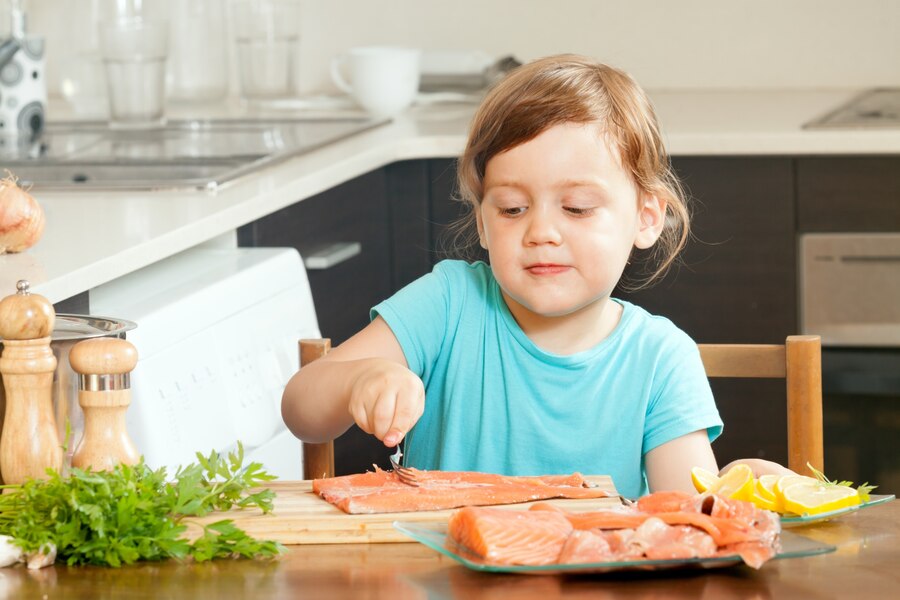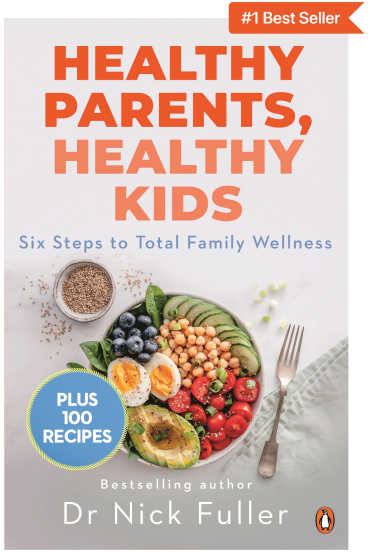How To Get Kids To Eat More Seafood

Dr Nick Fuller
Leading Obesity Expert at the University of Sydney and founder of Interval Weight Loss.

Seafood is packed with essential nutrients like omega-3 fatty acids, which are vital for brain development and overall health. However, convincing kids to dig into fish or shellfish isn’t always easy, especially when they prefer familiar, non-fishy flavours. So, how do you make seafood appealing?
Let’s explore some creative ways to introduce seafood to your child’s plate in a fun, enjoyable way.
Make Seafood Fun and Appealing for Kids
Getting your child to enjoy seafood doesn’t have to be a challenge. By making mealtimes more engaging, you can turn seafood into an exciting and tasty option. Dr Nick Fuller’s Healthy Parents, Healthy Kids offers practical tips on using playful strategies to spark your child’s interest. These simple techniques can transform seafood into an enjoyable experience, helping your child develop a positive attitude towards trying new, nutritious foods.
Grab your copy of Healthy Parents, Healthy Kids to discover more fun ways to introduce seafood into your child's diet!
Common Reasons Kids Refuse To Eat SeaFood
Understanding why kids might be hesitant can help you overcome the obstacle of getting them to try seafood. Let’s take a closer look at some of the most frequent roadblocks and how you can work through them.
Texture Issues
One of the biggest hurdles for kids when it comes to seafood is texture. Fish can be soft and flaky, while shellfish can have a chewy or rubbery feel. These textures can be off-putting to children who prefer more familiar foods like chicken nuggets or pasta. To make seafood more approachable, try experimenting with different cooking methods, like grilling or baking, to alter the texture, or blend seafood into other dishes such as pasta sauces or fish cakes.
Unfamiliar Flavours
Seafood has a distinct taste that may be unfamiliar to kids. For some, the ‘fishy’ flavour can be overwhelming and make them turn their noses up at the idea of trying it. To make seafood more enjoyable, start with milder options like white fish (e.g., cod or haddock) or try incorporating seafood into dishes with stronger, more familiar flavours, such as tacos or stir-fries. The goal is to ease them into the taste without overwhelming their tastebuds.
Smell Aversion
The smell of seafood can be a dealbreaker for kids, especially if they associate it with strong, off-putting odours. While cooking seafood, it’s important to use fresh ingredients and try to minimise the scent by preparing it with herbs, lemon, or other flavour-enhancing seasonings. You can also consider serving seafood in a more child-friendly presentation, like in small, bite-sized portions, to make the experience less intense.
Fear of Bones
For many kids, the idea of bones in fish can be a big deterrent. The fear of choking or getting caught on a bone often leads to refusal. To make seafood more appealing, opt for boneless fish fillets or teach your child how to properly navigate eating fish with bones. As they gain more confidence, they may be more willing to give it a try.
Negative Experiences
If a child has had a bad experience with seafood, whether it was the taste, texture, or even a reaction to an unfamiliar dish, they might develop a lasting aversion. Overcoming negative experiences takes patience, but a gradual reintroduction of seafood in a positive setting can help. Try to keep the atmosphere fun and stress-free, and introduce new dishes slowly, focusing on the positive aspects of the meal rather than pressuring them to eat.
Why Seafood Is Essential For Kids
Seafood is packed with nutrients that support your child’s health and development. Here’s why it’s an important food to include in their diet.
- Brain Development: Seafood, particularly fish like salmon, is rich in omega-3 fatty acids, which are great for brain health. Omega-3s help with memory, focus, and learning, giving your child a boost in school and everyday activities.
- Strong Immune System: They are full of vitamins and minerals like vitamin D and zinc, which help keep your child’s immune system strong. These nutrients support healthy growth and help protect against illness.
- Healthy Heart: Eating seafood regularly can help keep your child’s heart healthy by lowering the risk of heart disease in the future. Omega-3s found in fish also help reduce inflammation and improve heart function.
- Protein and Growth: Seafood is a great source of protein, which is essential for growth and development. Protein helps build muscles and repair tissues, supporting your child’s physical growth.
- Low in Mercury: Many types of seafood have lower levels of mercury, especially smaller fish like sardines or salmon. This makes seafood a safe and healthy choice for kids.
Tips To Get Kids To Eat More Seafood
With the right strategies, you can make seafood enjoyable and appealing for kids. Check out some creative ways to introduce seafood to your child’s diet, while keeping mealtimes fun and stress-free.
Start With Mild Flavours
If your child is new to seafood, start with milder-tasting fish like cod, haddock, or tilapia. These types of fish have a subtle flavour that’s less ‘fishy,’ making them easier to accept. You can gradually introduce stronger flavours like salmon or tuna once they get used to the taste. Serving seafood in a way that’s familiar to your child’s taste preferences can help them ease into it without feeling overwhelmed.
Incorporate Into Favourite Dishes
One of the easiest ways to get your child to eat seafood is by adding it to dishes they already love. Whether it’s pasta, tacos, or pizza, you can blend seafood into familiar recipes to make it feel less unfamiliar. Fish tacos, for example, can be a fun and tasty way to introduce seafood, while seafood pasta offers a chance to add extra flavour without the “fishy” taste taking over.
Use Fun Shapes
Kids love food that looks fun, so why not make seafood more appealing with creative presentations? Cutting fish into fun shapes or arranging seafood on the plate in a playful way can spark curiosity and excitement. Try making fish stick shapes or using cookie cutters to create fish-shaped bites. This simple trick can make seafood more visually appealing and exciting for your little one.
Cook Together
Getting kids involved in meal preparation can help them feel more connected to what’s on their plate. Invite your child to help cook seafood dishes, whether it’s dipping fish into the batter for fish sticks or assembling shrimp skewers. When they have a hand in making the meal, they’re more likely to want to try it. Plus, cooking together is a great bonding experience!
Offer Dips and Sauces
Dips and sauces are a great way to make seafood more exciting. Whether it’s a tangy tartar sauce, creamy garlic butter, or a simple squeeze of lemon, adding a dip can make the seafood more enjoyable and mask any flavours your child might not be fond of. Offer a variety of sauces to let your child choose their favourite, turning mealtime into a fun, flavourful experience.
Educate About Benefits
Sometimes, kids need a little extra motivation to try something new. Teach them about the benefits of eating seafood, such as how it helps them grow strong, healthy, and smart. You can also share fun facts about the different types of fish and seafood. For example, explain that fish like salmon are packed with brain-boosting omega-3s or that eating seafood helps keep their heart healthy. When kids understand the positive effects of seafood, they might be more eager to give it a try.
Key Takeaways
Getting your kids to eat more seafood can be easy and fun. Start with mild flavours, add seafood to their favourite meals, and make it more exciting with fun shapes and dips. Cooking together and explaining the health benefits can also help them enjoy it more. With these simple tips, you can make seafood a regular and enjoyable part of your child’s diet.
Keep on top of things with expert tips, top strategies, exclusive offers, and personalised support!
Meet Dr Nick Fuller
My Story
As a father, I know first-hand that raising healthy and happy children is tricky. Children are fussy, particularly at the end of the day when they are shattered. We also live in a society where companies seek to profit from what we feed our kids; incorrect and damaging advice is pushed on us and marketed towards our children, and we have no time.
But with these recipes and resources, you and your children can enjoy simple and well-founded food and lifestyle choices for lifelong health.

About Dr Nick Fuller
Dr Nick Fuller is the founder of Interval Weight Loss and is a leading obesity expert at the University of Sydney with a Ph.D. in Obesity Treatment. Dr Fuller is also the author of three best-selling books and his work been published in top ranked journals in the medical field, including JAMA, Lancet and American Journal of Clinical Nutrition.
